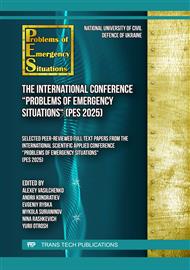[1]
Han Sung-Cheon, Tabiei Ala, Park Weon-Tae, Geometrically nonlinear analysis of laminated composite thin shells using a modified first-order shear deformable element-based Lagrangian shell element. Compos. Struct. 82 3 (2008) 465-474.
DOI: 10.1016/j.compstruct.2007.01.027
Google Scholar
[2]
Dung Nguyen Tien, Wells Garth N. Geometrically nonlinear formulation for thin shells without rotation degrees of freedom. Comput. Meth. Appl. Mech. And Eng. 197 33-40 (2008) 2778-2788.
DOI: 10.1016/j.cma.2008.01.001
Google Scholar
[3]
B. Plunkett, O. Caracu, F. Barlat, Orthotropic yield criteria for description of the anisotropy in tension and compression of sheet metals. Int. J. Plast. 24 5 (2008) 847-866.
DOI: 10.1016/j.ijplas.2007.07.013
Google Scholar
[4]
K. Washizu, Variational Methods in the Theory of Elasticity and Plasticity. Kyuichirou Washizu; Pergamon Pr; Subsequent edition, 1987.
Google Scholar
[5]
Green, A. E., Adkins, J. E.Large elastic deformations and nonlinear mechanics of continuous media, Oxford, Clarendon Press, 1965.
Google Scholar
[6]
M. S. Barabash, A. S. Gorodetsky. Continuing the stability of structures built up before the progressive collapse during emergency inflows. Scientific and technical journal: New technologies in everyday life. 2(20) (2010) 19–23.
Google Scholar
[7]
O.S. Sakharov, V.M. Kyslooki, V.V. Kyrychevskyi et al. Finite element method in mechanics of solids / edited by O. S. Sakharov. Kyiv: Higher School, Main Publishing House, 1982.
Google Scholar
[8]
Szymanovskyi O.V., Tsykhanovskyi V.K., Talakh S.M. Optimization of combined spatial systems / edited by Szymanovskyi A.V. Kyiv, Publishing house "Stal", 2012.
Google Scholar
[9]
Barabash M.S., Kostyra N.O., Pysarevskiy B. Y. Strength-strain state of the structures with consideration of the technical condition and changes in intensity of seismic loads. IOP Conference Series: Materials Science and Engineering, 708.
DOI: 10.1088/1757-899x/708/1/012044
Google Scholar
[10]
Barabash M.S., Kostyra N.O., Tomashevsky A.V. The value of stress-strain resistance of damaged load-bearing structures using PC "LIRA-SAPR" tools. Ukrainian magazine of everyday life and architecture. Dnipro. 1(007) (2022) 7-14.
DOI: 10.30838/j.bpsacea.2312.220222.7.827
Google Scholar
[11]
Maksimenko V. P., Barabash M. S., Pisarevsky B. Yu. Methodology for assessing the stress-strain structure of a structure based on the Subsystem method. Naukovo Tekhn. magazine "Budivelne Virobnitstvo", K.:NDIBV, 2021, No 71, ISSN: 2524-2555.
Google Scholar
[12]
Barabash M., Pisarevskyi B., Bashinsky Ya. Material damping in dynamic analysis of structures (with LIRA-SAPR program) / Civil and Environmental Engineering,. 16 1 (2020) 63-70.
DOI: 10.2478/cee-2020-0007
Google Scholar
[13]
Nemchynov, I. Building Science and Seismic Safety Provision in Ukraine Considering Eurocode Recommendations. Science and Construction, (29)3 (2021) 3-14.
Google Scholar
[14]
Nemchinov, Y.I., Marienkov, N.G., Khavkin, A.K., Babik, K.M. (Ed.). Design of Buildings with a Specified Level of Seismic Resistance. Kyiv, Hudymenko S.V., 2012.
Google Scholar
[15]
Powell, Graham. Progressive Collapse: Case Studies Using Nonlinear Analysis. SEAOC Annual Convention, Monterey, August, 2004.
Google Scholar
[16]
Gilmour J.R. and Virdi K.S. Numerical modelling of the progressive collapse of a framed structures as a result of impact or explosion. 2nd int. PhD. Symposium in civil engineering, Budapest 1998.
Google Scholar
[17]
Kaewkulchai G. and Williamson E.B. Beam element formulation and solution procedure dynamic progressive collapse analysis, Journal "Computer and Structures", 82 (2004) 639–651.
DOI: 10.1016/j.compstruc.2003.12.001
Google Scholar
[18]
Pretlove A.J., Ramsden M. and Atkins A.G., Dynamic Effects in Progressive Failure of Structures, International Journal of Impact Engineering, 11 4 (1991) 539–546.
DOI: 10.1016/0734-743x(91)90019-c
Google Scholar
[19]
Izzudin B.A., Vlassis A.G., Elghazouli A.Y., Nethercot D.A. Progressive collapse of multi-storey buildings due to sudden column loss, Part I, Engineering structures 20 (2008) 1308-1318; part II, Engineering structures 30 (2008) 1424–1438.
DOI: 10.1016/j.engstruct.2007.08.011
Google Scholar
[20]
Bashynska, O., Otrosh, Y., Holodnov, O., Tomashevskyi, A., Venzhego, G. Methodology for calculating the technical state of a reinforced-concrete fragment in a building influenced by high temperature. Materials Science Forum. 1006 (2020) 166–172.
DOI: 10.4028/www.scientific.net/msf.1006.166
Google Scholar
[21]
DSTU N B EN 1992-1-2:2012 (2013) Eurocode 2. Design of reinforced concrete structures. Kyiv: Ministry of Regional Development, Construction and Housing and Communal Services of Ukraine.
Google Scholar
[22]
DBN V.2.2-5:2023 (2023) Civil defense protective structures. Kyiv: Ministry of Community, Territories and Infrastructure Development of Ukraine.
Google Scholar
[23]
DBN V.2.1-10:2018 (2018) Bases and foundations of buildings and structures. Basic provisions. Kyiv: Ministry of Regional Development, Construction and Housing and Communal Services of Ukraine.
Google Scholar


